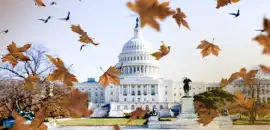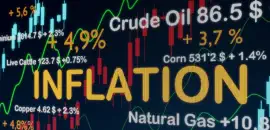Hopes were raised by a Wall Street Journal story that Fed officials would debate a slowdown in the pace of tightening at the November FOMC meeting. Previously, Chairman Jerome Powell and the September FOMC minutes indicated that the Fed does not plan to hike rates by 75 basis points much longer.
Markets rallied following the announcement of the latest rate hike, but then sold off when Powell indicated the Fed was likely to raise rates to higher levels than officials previously envisioned. He also stated that it was premature to talk about pausing rate hikes.
Prior to the meeting, the bond market was pricing in a 50-75 basis point hike in December 2022, and two 25 basis point increases in February and March 2023 before the Fed pauses. In that event, the funds rate would peak around 5% in the first quarter of next year and level off thereafter. If so, interest rates adjusted for core inflation would be slightly positive.
Meanwhile, financial market conditions as measured by Goldman Sachs’s index are the tightest since the onset of the COVID-19 pandemic. For the Fed to pause, officials must be confident that core inflation is trending down. It is currently running at about a 5% pace, and the September FOMC projections foresee it declining toward 3% next year and approaching the Fed’s 2% average annual target by 2024.
Three Factors Likely Needed for the Fed to Pivot
So, what factors could produce a quicker pivot than the market is anticipating or even a policy reversal? There are three likely candidates to consider.
The first would be a more rapid increase in unemployment than the Fed contemplates. For their part, officials acknowledge that the economy is likely to be flat this year, and they foresee only a modest upturn next year. But, they still envision a “soft landing” in which unemployment peaks at 4.5% in the next two years. If so, the Fed is unlikely to stop raising rates any time soon.
The risk, however, is that the economy slips into recession next year and the unemployment rate moves higher than what officials anticipate. If it were to reach 5% or more, pressures for the Fed to ease policy would undoubtedly build, especially if the increase was rapid.The second factor is an unanticipated development that could cause policymakers to worry about financial instability. In 1998, for example, the Fed was contemplating tightening monetary policy, but then lowered rates three times when long-term capital management collapsed and posed a risk to the financial system. The Fed also eased policy in 2008 in the wake of Bear Sterns’s collapse and subsequent problems that ensued during the Global Financial Crisis (GFC).
Today, by comparison, the risk of a recurrence is relatively low because U.S. banks are more highly capitalized today, and there is better regulatory oversight. But according to Professor Richard Berner of New York University’s Stern School of Business, “…little has been done to address vulnerabilities in nonbank financial firms and in critical financial markets, which intermediate half or more of credit supplied, and whose resilience is critical for financial stability.”
Berner goes on to cite vulnerabilities, including the ongoing conflict in Ukraine, an energy crisis in Europe, and growing sources of climate, cyber and other risks. He also cites the recent turmoil in the U.K. gilt market as symptomatic of the vulnerabilities that exist today. From my perspective, these factors are wild cards that are difficult to predict, but can surface at any time.
The third factor could be debt problems in developing countries, stemming from rising interest rates and a strong dollar. This combination contributed to the LDC Debt Crisis in 1982-83, which caused Fed Chairman Paul Volcker to back away from tightening monetary policy. The same was true during the Mexican peso crisis in late 1994 and 1995, when Alan Greenspan stopped raising U.S. interest rates to avert contagion in Latin America.
An important difference today is that emerging economies in Asia and Latin America have become less dependent on foreign capital since the Asian Financial Crisis in 1997, and many permit greater exchange rate flexibility to serve as a shock absorber. In addition, the COVID-19 pandemic resulted in steep declines in imports and increased remittances for many Latin American countries that improved their current account positions, and some are now in balance or surplus. And, the surge in commodity prices has further benefitted the current account positions of net energy exporters.
Still, this does not mean that policymakers and investors can ignore idiosyncratic risks with individual countries such as Argentina, South Africa and Turkey, which are currently in the spotlight. Brazil could also become a focal point because inflation and interest rates are elevated and the economy has weakened. Meanwhile, the World Bank has warned that many poorer countries will require increased official assistance to counter the effects of the pandemic and rising prices for food and energy.
Weighing these considerations, I believe investors are more realistic about the Federal Reserve’s current interest rate policy, after they were woefully complacent. For the Fed to pivot from tightening policy, it must be confident that inflation is on a downward trajectory. The main challenge ahead is how it would respond if unemployment reached 5% or more and inflation stayed elevated at 3% -4%. The reason: it would provide a clear test of the Fed’s determination to bring inflation under control.
Past performance is not indicative of future results. This publication contains the current opinions of Fort Washington Investment Advisors, Inc. Such opinions are subject to change without notice. This publication has been distributed for informational purposes only and should not be considered as investment advice or a recommendation of any particular security, strategy, or investment product. Information and statistics contained herein have been obtained from sources believed to be reliable and are accurate to the best of our knowledge. No part of this publication may be reproduced in any form, or referred to in any other publication, without express written permission of Fort Washington Investment Advisors, Inc.

























